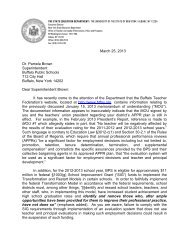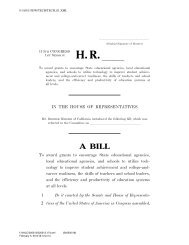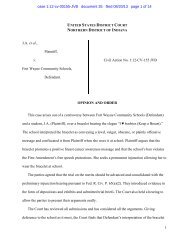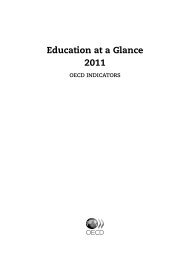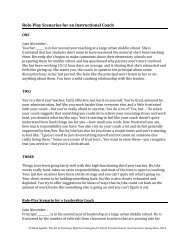Testing More, Teaching Less - American Federation of Teachers
Testing More, Teaching Less - American Federation of Teachers
Testing More, Teaching Less - American Federation of Teachers
- No tags were found...
You also want an ePaper? Increase the reach of your titles
YUMPU automatically turns print PDFs into web optimized ePapers that Google loves.
APPENDIXResearch on Time Used for Test PreparationAlthough there is rich literature on test preparation,very little research exists on the time students spendpreparing for tests. Our study creates a rubric (Table4) for estimating test prep time based on findingsfrom two high-quality studies.Center for the Study <strong>of</strong> <strong>Testing</strong>, Evaluation, andEducational Policy. The 80-item survey <strong>of</strong> teachers(Pedulla et al., 2003) sought to ascertain teacher’attitudes and opinions about state-mandated testingprograms and then analyzed the data according tothe nature <strong>of</strong> the consequences or stakes attached totheir state test results. For districts, schools or teachers,high stakes refers to state-regulated or legislatedsanctions <strong>of</strong> significant consequence such as accreditation,financial rewards or placing a school inreceivership. The low-stakes category included stateswith testing programs that did not have any knownconsequences attached to test scores. If the stakesattached to the state tests did not meet the criteria <strong>of</strong>either the high- or low-stakes definitions, states wereplaced in the moderate category.Responding to the question, “Approximately howmany class hours PER YEAR do you spend preparingstudents specifically for the state-mandated test (i.e.,teaching test-taking skills)?” teachers responded asfollows:In high-stakes states, 13 percent <strong>of</strong> teachersspent 21-30 hours on test prep, and 44 percentdevoted more than 30 hours to test prep.In low-stakes states, 7 percent <strong>of</strong> teachers spent21-30 hours on test prep and 44 percent devotedmore than 10 hours to test prep.The study found that test prep practices vary withthe stakes attached to testing. Chosen from a list <strong>of</strong> testpreparation practices, the largest differences betweenteachers in high-stakes and low-stakes states are:“I provide students with items similar to those onthe test” (75 percent compared to 54 percent);“I provide test-specific preparation materialsdeveloped commercially or by the state” (63percent compared to 19 percent); and“I provide students with released items fromthe state-mandated test” (44 percent comparedto 19 percent).<strong>Teachers</strong> in high-stakes states were much morelikely to report that their districts required or recommendedsummer school for low-scoring students(43 percent compared to 8 percent), or retain studentsin grade (25 percent compared to 3 percent).Consortium on Chicago School Research: Thecenterpiece <strong>of</strong> Chicago’s high-stakes testing programimplemented in the late 1990s was a set <strong>of</strong>minimum test score standards on the reading andmathematics sections <strong>of</strong> the Iowa Test <strong>of</strong> Basic Skillsfor students in grades 3, 6 and 8. Students who didnot meet the test score cut<strong>of</strong>fs at the end <strong>of</strong> theschool year were required to participate in a specialsummer program.Survey data collected by the consortium (TepperJacob and Stone, 2005) showed that teachersdefined test preparation narrowly. <strong>Teachers</strong> didcount giving practice tests and teaching test-takingstrategies as test prep. <strong>Teachers</strong> did not count activitiesaligning content to the test as test prep. Half <strong>of</strong>the teachers, for instance, said they had aligned thecontent <strong>of</strong> their curriculum with the content <strong>of</strong> thetest, but only 4 percent included curriculum contentin what they considered “test preparation.” Based oninterviews, teachers viewed test preparation as themost effective way to improve test scores. <strong>Teachers</strong>used a variety <strong>of</strong> approaches to test prep emphasizing,above all, test simulation and familiarizationwith the layout and format.Data collected from teacher surveys beforeimplementation <strong>of</strong> the high-stakes social promotionpolicy in 1994, and after five years <strong>of</strong> implementationin 1999, yielded teacher estimations <strong>of</strong> timethey spent on test preparation:<strong>Testing</strong> <strong>More</strong>, <strong>Teaching</strong> <strong>Less</strong> 29



